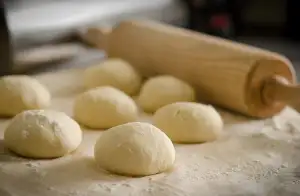Master the Art of Making Ricotta Cheese at Home with This Step-by-Step Recipe

Ricotta cheese, a creamy and versatile dairy product, originates from Italy and is known for its delicate flavor and smooth texture. Unlike traditional cheeses that are made through fermentation and aging, ricotta is produced by reheating whey leftover from cheese production or by curdling milk with an acid. Ricotta translates to "recooked" in Italian, reflecting the process of heating the liquid until the proteins coagulate into soft curds. This fresh cheese is commonly used in both sweet and savory dishes due to its mild taste, making it a staple in many cuisines around the world.
Ingredients Required
To make homemade ricotta cheese, you will need just a few simple ingredients that are easily accessible. The key ingredients include whole milk, acid (such as lemon juice or white vinegar), and salt. These basic components are essential for curdling the milk and separating the curds from the whey to create the creamy ricotta texture we all love. Additionally, you may choose to add cream for a richer consistency or herbs for added flavor, depending on your preference. Remember to use high-quality ingredients for the best results in your homemade ricotta cheese.
Equipment Needed
To make homemade ricotta cheese, you will need a few basic kitchen tools. Here is a list of essential equipment needed:
1. Large stainless steel or non-reactive pot: Choose a pot that can comfortably hold the amount of milk required for your recipe without boiling over.
2. Thermometer: A kitchen thermometer is crucial to monitor the temperature of the milk accurately.
3. Slotted spoon: This will help you gently stir and scoop out the curds during the draining process.
4. Cheesecloth or fine-mesh strainer: To strain the curds from the whey, you will need either cheesecloth or a fine-mesh strainer.
5. Mixing bowl: Use a large bowl to catch the whey as it drains from the curds.
6. Storage container: Have a clean container ready to store your freshly made ricotta cheese in the refrigerator once it's done.
Having these essential tools on hand will ensure that your homemade ricotta cheese-making process goes smoothly and yields delicious results.
Step-by-Step Instructions
1. Heating the Milk:
- Pour whole milk into a large pot and heat it over medium heat, stirring occasionally to prevent scorching.
- Use a thermometer to monitor the temperature until it reaches around 185°F (85°C).
2. Adding Acid:
- Once the milk reaches the desired temperature, add white vinegar or lemon juice slowly while stirring gently.
- Continue to stir for about 1-2 minutes until you see curds starting to form.
3. Draining the Curds:
- Line a colander with cheesecloth and place it over a large bowl.
- Carefully pour the curdled mixture into the cheesecloth and let it drain for about 15-30 minutes, depending on desired consistency.
Heating the Milk
Heating the milk is the first crucial step in making ricotta cheese at home. Start by pouring whole milk into a large, heavy-bottomed pot and place it over medium heat. Stir the milk occasionally to prevent scalding and ensure even heating. Use a thermometer to monitor the temperature; you want to heat the milk to around 185°F (85°C). This process helps denature the proteins in the milk, allowing them to coagulate later on when you add acid. Be patient during this step as slow, steady heating is key to achieving a creamy ricotta texture.
Adding Acid
Adding acid is a crucial step in the process of making ricotta cheese at home. Once the milk reaches the desired temperature, it is time to add the acid that will cause the proteins in the milk to coagulate and form curds. Common acids used for this purpose include white vinegar, lemon juice, or citric acid. Stir gently after adding the acid to ensure it is evenly distributed throughout the milk. Allow the mixture to sit undisturbed for a few minutes to allow the curds to fully develop before moving on to the next step of draining them.
Draining the Curds
Once the curds have formed, it's time to separate them from the whey. Line a colander with cheesecloth and place it over a large bowl. Carefully pour the curds and whey into the colander, allowing the whey to drain off. Let the curds sit and continue draining for about 15-30 minutes, depending on how dry you prefer your ricotta.
For a creamier texture, drain for less time; for a drier ricotta that's great for baking, drain longer. Once drained to your desired consistency, transfer the ricotta to an airtight container and refrigerate until ready to use. Homemade ricotta is now ready to elevate your dishes with its fresh flavor and creamy texture!
Tips for Making Ricotta Cheese at Home
1. Use whole milk for a richer and creamier ricotta.
2. Avoid ultra-pasteurized milk as it may affect the curd formation.
3. Be patient while heating the milk to ensure proper curd formation.
4. Use a thermometer to accurately monitor the milk temperature.
5. Stir gently when adding the acid to prevent breaking up the curds too much.
6. Let the curds sit undisturbed for optimal draining and texture.
7. Experiment with different acids like lemon juice or white vinegar for unique flavors.
8. Store homemade ricotta in an airtight container in the refrigerator for up to 4-5 days.
Mastering these tips will elevate your homemade ricotta cheese, allowing you to enjoy its fresh taste and versatility in various dishes.
Serving Suggestions
Ricotta cheese is a versatile ingredient that can be used in both sweet and savory dishes. For a classic Italian touch, spread freshly made ricotta on toasted bread and top with a drizzle of honey and a sprinkle of sea salt for a simple yet delicious snack. Incorporate ricotta into pasta dishes like lasagna or ravioli for added creaminess and flavor. It also works well in desserts such as cannoli filling, cheesecakes, or even pancakes for a fluffy texture. Experiment with incorporating herbs like basil or thyme, or flavors like lemon zest or chili flakes to customize the ricotta to suit your dish. The possibilities are endless with this homemade cheese!
Making ricotta cheese at home is a rewarding culinary experience that allows you to appreciate the artistry of food in a whole new way. By following this simple step-by-step recipe, you can create a fresh and creamy cheese that surpasses store-bought versions in both flavor and quality. With just a few basic ingredients and equipment, you can master the craft of ricotta cheese making and impress your family and friends with your homemade delicacy. So, roll up your sleeves, embrace the process, and enjoy the delicious results of your homemade ricotta cheese!
Published: 07. 05. 2024
Category: Recipes



